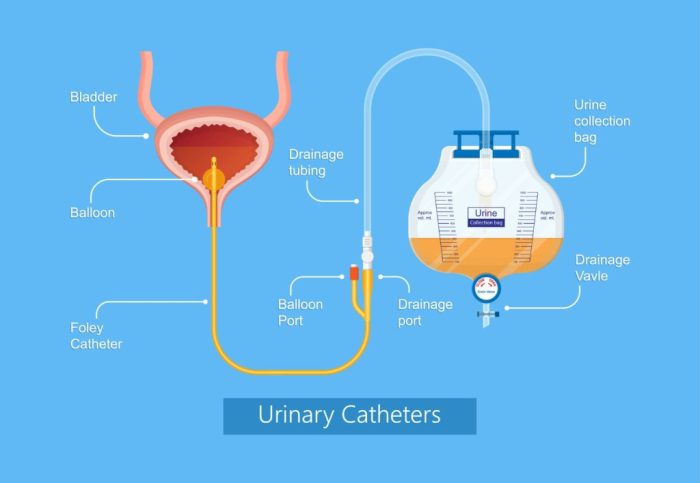Foley catheter care nurse teaching plays a crucial role in ensuring patient safety and preventing complications associated with urinary catheterization. Nurses must possess a thorough understanding of foley catheter care, including assessment techniques, insertion and removal procedures, maintenance protocols, potential complications, and patient education strategies.
This comprehensive guide will delve into the intricacies of foley catheter care, providing nurses with the knowledge and skills necessary to deliver optimal care to their patients.
Foley Catheter Care for Nurses
Foley catheter care is an essential nursing skill that involves maintaining the patency and preventing infection of an indwelling urinary catheter. This article will discuss the purpose, types, assessment, insertion, removal, maintenance, and potential complications of foley catheters.
Assessment
Before and after foley catheter insertion, nurses should assess the patient’s condition to identify any potential complications. This includes evaluating the patient’s vital signs, urine output, and abdominal pain. Additionally, nurses should inspect the catheter insertion site for any signs of infection or irritation.
Signs and Symptoms of Complications
- Fever
- Chills
- Cloudy or foul-smelling urine
- Pain or burning during urination
- Suprapubic pain
Insertion and Removal
Foley Catheter Insertion
Foley catheter insertion is a sterile procedure that requires proper technique and patient positioning. The nurse should clean the insertion site and insert the catheter into the urethra using aseptic technique. The balloon is then inflated with sterile water to secure the catheter in place.
Foley Catheter Removal
Foley catheter removal is a simple procedure that can be performed by a nurse. The nurse should deflate the balloon and gently remove the catheter from the urethra. The insertion site should be cleaned and monitored for any signs of infection.
Maintenance and Care

Proper foley catheter care is essential to prevent infection and maintain catheter patency. This includes cleaning the catheter insertion site daily, securing the catheter to prevent movement, and monitoring for any signs of infection.
Maintaining a Closed Drainage System
Maintaining a closed drainage system is crucial to prevent bacteria from entering the catheter. The drainage bag should be kept below the level of the bladder and emptied regularly.
Preventing Catheter Blockages
Catheter blockages can occur due to sediment or blood clots. To prevent blockages, nurses should flush the catheter with sterile water every 8 hours.
Complications

Urinary Tract Infections
Urinary tract infections (UTIs) are the most common complication of foley catheter use. Signs and symptoms of a UTI include fever, chills, cloudy or foul-smelling urine, and pain or burning during urination.
Bladder Spasms, Foley catheter care nurse teaching
Bladder spasms can occur when the catheter irritates the bladder wall. Symptoms of bladder spasms include pain, urgency, and frequency of urination.
Urethral Trauma
Urethral trauma can occur during catheter insertion or removal. Signs and symptoms of urethral trauma include pain, bleeding, and difficulty urinating.
Patient Education: Foley Catheter Care Nurse Teaching
Patient education is essential to ensure proper foley catheter care. Nurses should provide patients with instructions on how to recognize and report any problems, such as pain, cloudy urine, or fever.
Examples of Patient Education
- How to clean the catheter insertion site
- How to secure the catheter
- How to monitor for signs of infection
- When to call the nurse
Questions Often Asked
What are the signs and symptoms of a urinary tract infection (UTI) in a patient with a foley catheter?
Signs and symptoms of a UTI in a patient with a foley catheter include fever, chills, cloudy or foul-smelling urine, increased frequency or urgency of urination, and pain or burning during urination.
How often should a foley catheter be changed?
The frequency of foley catheter changes varies depending on the patient’s condition and the type of catheter used. In general, foley catheters should be changed every 7-14 days.
What are the potential complications associated with foley catheter use?
Potential complications associated with foley catheter use include urinary tract infections, bladder spasms, urethral trauma, and catheter blockage.